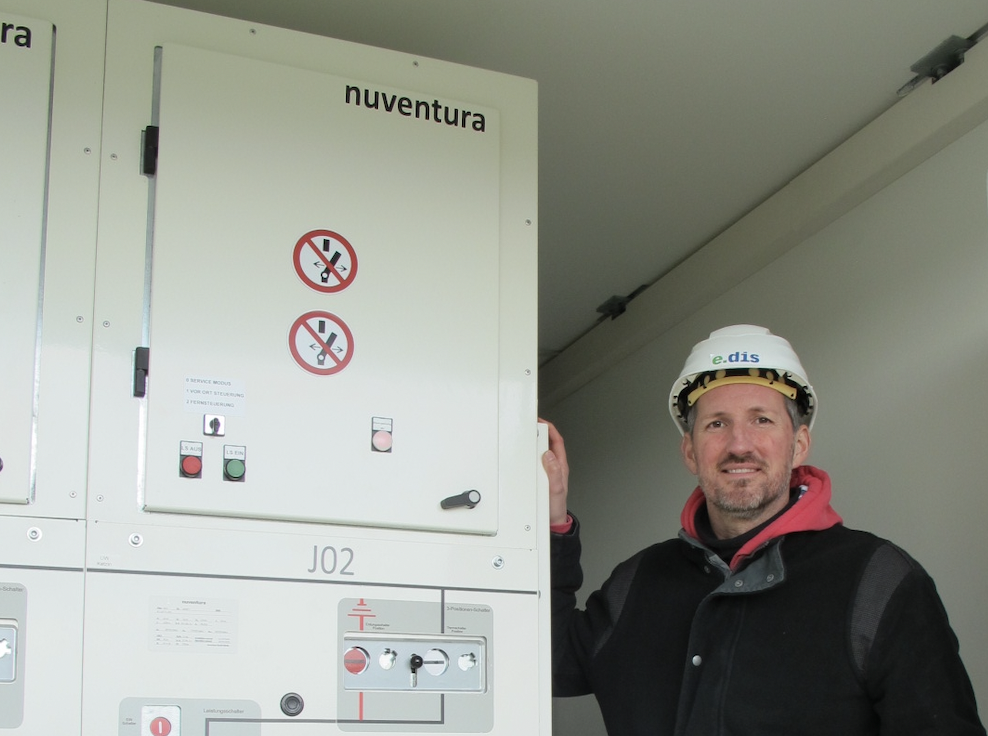The “Green Grids Initiative” announced November 3 by the U.K. and India at the COP26 climate summit aims to improve connections between the world’s electricity power grids to accelerate the transition to green energy. It is being backed by more than 80 countries and could set the way for developed countries to help poorer ones to reduce their emissions and meet the goal of capping global warming at 1.5 degrees Celsius.
The end goal may be to offset climate change but there’s a hitch. The Green Grids Initiative, as well as burgeoning markets for electric vehicles and energy storage, are expected to add to the enlargement of power grids with high and ultra-high voltage transmission lines, substations, and other infrastructure.
The trouble is much of the world’s energy networks are connected by switchgear filled with a synthetic odorless gas called Sulfur Hexafluoride (SF6), a potent greenhouse gas (GHG) , with a warming potential over 25,000 times that of carbon dioxide (CO2) and atmospheric residence of up to 3,200 years. Without a change in the underlying transmission and distribution grids, ambitious energy transition projects could potentially make things worse.
That’s where nuventura, a Berlin-based startup, comes in. It develops gas insulated switchgear (GIS) technologies that help to reduce the energy industry’s use of SF6 – which has traditionally been used as an insulating medium in GIS – by replacing it with dry air. The company is currently trialing the use of its technology with E.DIS, a German distribution system operator and subsidiary of E.ON, the world’s largest investor-owned electric utility service provider.
It is yet another example of how collaborations between startups and traditional companies can help solve the United Nations Sustainable Development Goals.
On November 2, nuventura joined some of the world’s largest manufacturers of electrical transmission and distribution (T&D) equipment in issuing a statement calling for the urgent need to develop fluoride-gas free T&D equipment. The manufacturers said the move would serve as “a hugely significant step towards the decarbonization of the energy grid.”
The clean transport of low-carbon electricity is an essential element of national decarbonization plans, which will underpin the sustainable economies of the future, the manufacturers said in their statement. “In conjunction with decarbonized power generation using renewable energy sources, it is vital to do the same for T&D power grids upon which the system relies,” they said.
Eliminating The Equivalent of Annual CO2 Emissions From 100 Million Cars
For over fifty years, the recognized insulation and switching performance, as well as proven and stable characteristics of SF6, have contributed to the reliability, efficiency, and resilience of power network facilities, enabling compact equipment for all voltage classes.
But when this switchgear ages or is disposed of in landfills the SF6 gas leaks. Some 8000 tons of SF6 gas is emitted into the atmosphere per year, the equivalent of CO2 emissions from 100 million cars, says Nicholas Ottersbach, nuventura’s senior business development and marketing manager.
In Europe and the U.S. the processes around the recycling of switchgear are better established and more effectively carried out, he says. SF6 is generally mixed with new gas and used again in new equipment, but in developing countries the recycling process for the gas and the hardware itself seems to be less well-defined and executed. “This has received little attention but anecdotally it seems like often the switchgear ends up in landfills with the greenhouse gas still inside it, so it is emitted into the atmosphere with time,” says Ottersbach. “As a broad rule, in the European Union we can expect a medium voltage switchgear’s total lifetime SF6 emissions to be anywhere from 1.5% to 10%. In developing countries this is bound to be significantly higher,” he says.
What’s more, if things continue as they are, by 2030 the usage of switchgear filled with SF6 is expected to increase by 75% from 2019 levels, partly due to the energy transition, but mainly because of the accelerating electrification of different parts of the world, he says.
To enable truly sustainable power grids, “we need to limit the SF6 emissions and install new electrical equipment using clean reliable, and non-toxic alternatives,” the manufacturers said in their statement. In addition to nuventura, signatories include Siemens Energy, Schneider Electric, Toshiba and Mitsubishi Electric.
All of the signatories have already developed or are in the process of developing T&D equipment free of fluorinated gases.
Like nuventura, Siemens and Schneider Electric are using dry air as a replacement for SF6, while ABB is using another GHG called C5 (or AirPlus).“What differentiates nuventura from the others, especially Siemens and Schneider, is that our technology is the only dry air GIS that covers the medium voltage range up to 36 kV,” says Ottersbach. “Siemens and Schneider so far have only developed dry air GIS for the 24 kV voltage range. Different use cases (and geographical regions) require switchgear specially designed for those specific voltage ranges.”
The Search For A Better Way
The Berlin-based startup is the brainchild of electrical engineer Manjunath Ramesh. After 10 years working in R&D for the power industry,he became increasingly concerned about the long-term environmental impact of SF6 , which is found in most medium voltage switchgear. He wanted to work on a replacement but could not muster interest from Schneider Electric, his employer at the time. So, he quit and teamed with Nikolaus Thomale, a serial entrepreneur, and Fabian Lemke, a former McKinsey energy sector consultant. The three founded nuventura in July 2017. The company has since developed, built and tested the new air technology and secured licensing and pilot partners for operation. Nuventura’s investors include Future Energy Ventures, the venture capital investment and collaboration platform of E.ON.
It was E.ON that connected nuventura to its subsidiary E.DIS, one of Germany’s largest regional energy service providers. E.DIS’ electricity grid covers 80,000 km and its gas grid covers 4.300 km.
“Utilities often, and understandably, adopt a ‘safety-first’ approach when it comes to introducing new technologies into their grids, which naturally can lead to skepticism and lack of innovation,” says Ottersbach. “This is why the trial with E.DIS is so important. It shows that early adopters are testing sustainable alternatives and gathering experience with these technologies.”
The collaboration marks the first time that E.DIS has ever worked with a startup on switchgear, say Andreas Freygang, a E.DIS substation expert.
Sebastian Schaefer, E.DIS’ Innovation Manager, described the process as positive. He said an added benefit of working with a startup is that it is possible to do co-development and adapt the product to the utility’s needs.
E.DIS has been testing nuventura’s technology under real conditions on its grid since April, said Freygang. The startup’s technology works well, he says. The challenge for scaling, for now, is that nuventura is relying on a small manufacturer to assemble the switchgear. The startup only supplies the technology to replace SF6, not the hardware itself. It is difficult for the startup to compete with manufacturers who have been making electric switches for 50 years or more, says Freygang. He said E.DIS is also testing Siemens’ CleanAir switch and is still evaluating the available technology options.
Nuventura says the arrangement with the local switch maker is purely for demonstration purposes. It is in talks with established switch manufacturers about incorporating its switch technology. “Our business model is to license our technology to switchgear manufacturers and sell them key components to incorporate into their own switchgear designs,” says Ottersbach. “We will soon be part of projects involving replacing existing switch gear or completely new infrastructure projects.”
Regulators in the U.S. and Europe are cracking down on the use of SF6 by the electricity sector, he says. And other regions are sure to follow. “Our technology will have to be adapted for different regulatory frameworks and standards, but the technology can work all over the world,” says Ottersbach. “Our next big ambition is to address the Asian market, which is the fastest growing the world.”
How Other Technologies Could Help The Energy Sector Go Green
Getting rid of SF6 emissions won’t be enough to help the energy sector go green. Despite a decline in 2020, global energy-related CO2 emissions remained at 31.5 Gt, which contributed to CO2 reaching its highest ever average annual concentration in the atmosphere of 412.5 parts per million in 2020 – around 50% higher than when the industrial revolution began, according to the International Energy Agency.
To achieve global net-zero emissions by 2050, every sector of the energy economy needs to eliminate emissions completely. This would require investments in energy infrastructure to total between $92 trillion and $173 trillion between 2020 and 2050, according to a September 2021 report by The World Economic Forum in collaboration with BloombergNEF and Deutsche Energie-Agentur (dena).
To accelerate the shift towards a widespread, affordable, low-carbon energy supply, there is a need for greater optimization of every aspect of this energy system, as well as greater coordination and cooperation between each component, says the report. This requires a better understanding of, and better mechanisms to monitor and control, the ways in which power grids, buildings, industrial facilities, transport networks, and other energy-intensive sectors integrate and interact with one another. The report says that AI has tremendous potential to support and accelerate a reliable and lowest-cost energy transition, with potential applications ranging from optimizing and efficiently integrating variable renewable energy resources into the power grid, to supporting a proactive and autonomous electricity distribution system, to opening up new revenue streams for demand-side flexibility.
To that end, Future Energy Ventures, the venture capital investment and collaboration platform of E.ON, invested a few years ago in gridX, a German smart grid company that is enabling the energy transition by developing scalable infrastructure to connect and control distributed energy resources.
GridX’s solutions, which are based on artificial intelligence and real-time edge data, enable the dynamic distribution of available grid power. This helps optimize the charging processes of end-user products as well as ensuring that peak loads are avoided. After successfully testing gridX’s intelligent load management system at its headquarters in Essen, Germany, E.ON decided to roll out the technology in eleven other countries. In September E.ON also announced that it will acquire a majority stake in gridX, in order to build on previous collaborative success , says Aaron Israel, a member of the investment team at Future Energy Ventures.
E.ON’s collaborations with Nuventura and gridX are good real-world examples of how cooperation between energy giants and startups and scale-ups have the potential to have an impact on the transition of the energy sector and the pursuit of a greener and more sustainable future, say Israel. To date, Future Energy Ventures has successfully initiated collaborations between E.ON business units and most of the companies in its portfolio, he says. It is currently in the process of raising a second fund focused on digital startups that can transform the traditional energy value chain. To that end, it aims to partner with additional strategic investors in the utilities and adjacent sectors that seek to partner with innovative startups in the space.
This article is content that would normally only be available to subscribers. Sign up for a four-week free trial to see what you have been missing.







